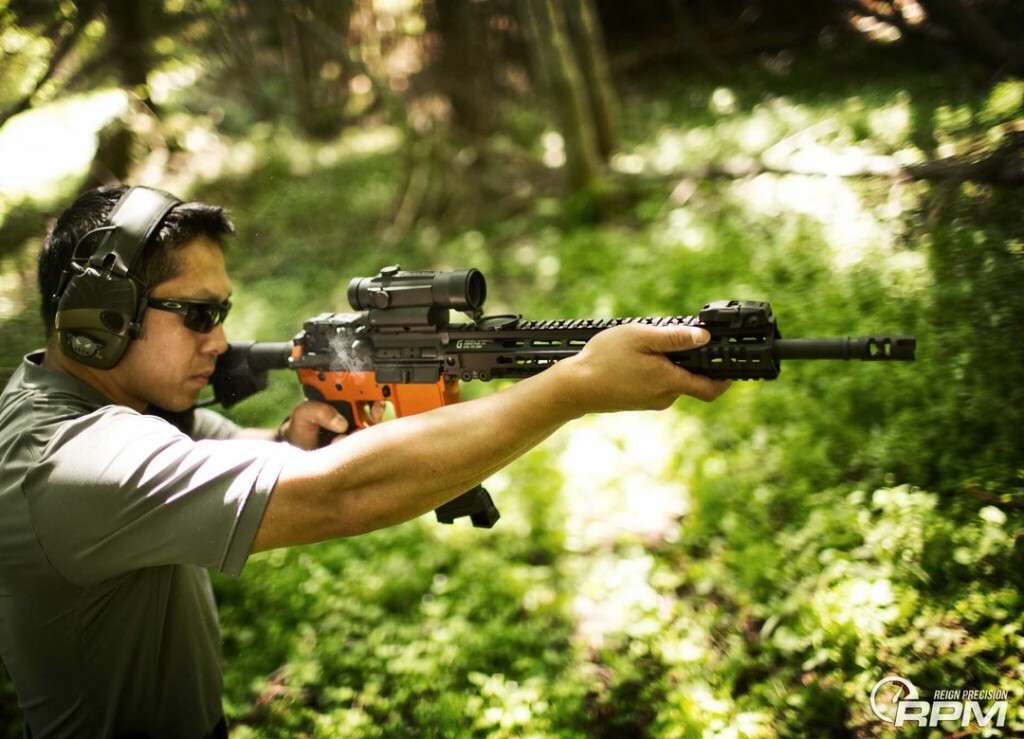Fathom Arms – Understanding the Process of Quality
By: Chris Tran
Photo Credits: David Thorson/ TracerX Photography /Reign Precision Marketing
At some point, any market will hit a saturation point. This holds true to arms manufacturers as well. Too much supply and not enough demand will kill off smaller companies, and 2014 has seen one or two fall by the wayside. I mentioned before in a previous article that customer service has really proven to be king: smart companies know that with such a soft market and with so many options available, end users will gravitate towards the companies that not only offer superior products, but know how to take care of their customers.
The good guys at Blacksheepwarrior.com once again came through and connected me with a company called Fathom Arms. Fathom Arms is new to the market, having only just officially started in 2013. I have been impressed with Fathom Arms since the moment I got in touch with owner Guy Kemp.
The Man Behind Fathom Arms
I like to know about the people behind the company; Guy had this to say about himself:
My background is aviation. More aviation engineering than anything else. I worked and built MQ-1 and MQ-9 UAVs and did a few tours to Afghanistan in support. Before that I was in the Navy.
After MQ-1s and MQ-9s, I was head hunted by Lockheed Martin and hired as a Field Engineer for their Advanced Development Program aka Skunk Works. I did over 11 total tours to Afghanistan over the last 7 years.
Having a background in aviation makes my quality control very OCD. Everything is individually hand inspected and I do not let anything go out the door unless I have personally inspected it.
Everything we do is methodical. It’s not about pumping product out and every upper is built like I’m building it for myself.”
The Rundown
Guy sent me a complete Fathom Arms carbine gas system upper to test out and run for a bit. Rest assured, these uppers are OEM and in the league of larger, more popular named brands out there right now. Right out of the box, I was impressed. The 7075 T6 aerospace grade aluminum forged upper is smooth and sleek with an understated pre-anodized laser-engraved logo on the left side. The interior of the upper is dry-lubed. The anodizing is outstanding: slick, sleek, and almost with more of a matte finish.
I compared it to a Mega Arms, Seekins Precision, and Rainier Arms forged uppers that I have, and the Fathom Arms is on par in terms of uniformity of application, but not with a rich black hue such as with Mega, blackness was in between the Seekins and the Rainier Arms, with surface slickness more towards the Rainier Arms forged upper.
The only blemish I found on the upper itself were light brass markings on the shell deflector – meaning that Guy was true to his word; each upper is test fired for quality and consistency before leaving the factory.
The Fathom Arms upper comes with a carbine gas system complete with a melonited gas tube (nice additional touch), and the barrel is sheathed with a Geiselle MK4 13” keymod rail. (Editors Note: Future builds will feature the new Geiselle MK8 M-LOK)
The charging handle is a BCM Mod 4, and the muzzle device is a PWS 556. All outstanding upgrade components to have on an upper build, but in this case, I had some of the best the industry had to offer right out of the box.
I asked Guy about his outside-manufacturer component choices, specifically the Geiselle and Bravo Company selections, and he had this to say:
“Well, I hate when I would buy high end uppers and I would get a generic charging handle strictly because the manufacturer didn’t want to push another brands’ products. BCM’s charging handle is superior in durability and design, so I’m not going to short my customers with a subpar product just for them to upgrade to it anyways.
I went with the MK4 keymod due to the fact that the machining is exceptional and the way the hand guard lines up the upper is probably the best I have ever seen. It’s flush on all angles. I also am a big fan of those anti rotation tabs with the adjustment screws. Also, with the aluminum barrel nut, it is lightweight when compared to the durability.”
With such attention to detail already proven, I got even nosier and wanted to know about the barrels Guy chose to use. Now while the maker is proprietary information at this point, the barrels are 41V50 16” carbine-gas length, with a 1:8 twist rate and a .750” low profile gas block. Barrels are button rifled, thermo stress relieved, and precision air gauged. The barrel comes standard with M4 barrel extensions, and chrome-lined bore and chamber.
Guy explained his assembly process to me:
“Our build process is straight forward. Cut no corners, use the proper equipment, hand inspect everything, and do not send anything out the door that you do not trust your own life with. All barrels are torqued to 50 ft lbs and head spaced checked to SAAMI specs, not NATO. We do not use a field gauge. Everything is go, NO-GO. If it doesn’t pass SAAMI it’s rejected. Moly grease is also applied in the barrel threads and it is torqued, backed off, and re-torqued. Twice.
All muzzle devices are torqued to 15-20ft lbs. no more than that. A barrel clamp is used next to the device to reduce any excess tension on the barrel”
Guy wanted to make sure readers understand that Fathom Arms will shortly transition to nitride 41V50 barrels – he is very excited about this enhancement, and believes it will only make his outstanding upper receiver groups even better.
Rounds Downrange
For my first few range sessions, I mated my evaluation upper to a Lockestone Industries lower, which was equipped with a Hiperfire 24 trigger system. I used two different sighting systems; standard run-of-the-mill Magpul MBUS Sight, and later, a Primary Arms 4X Compact Prism Scope
.
As to be expected, with such assembly attention to detail and quality components, the Fathom Arms upper receiver group was a dream to shoot. With rapid strings of fire enabled by the Hiperfire 24, the carbine cycled flawlessly all day without a hiccup.
The PWS 556 performed admirably as well – it barked loudly as should be expected, but mitigated rise exceedingly well; I easily kept 10-string rapid fire shots within paper plate sized-diameter groups at 15 yards.
From the bench, using a Primary Arms 4X Compact Prism Scope I was also very easily able to achieve sub-MOA groups at 50 yards (go ahead and follow me in Instagram to see target results if you need verification). Follow-up range runs will be out to 100 yards as time allows, as well as some close-distance drills.
Things to Come
I actually have, in my hot little hands, a brand new Fathom Arms bolt carrier group that is simply a work of art. Designed and executed by an industry forerunner, this BCG has subtle nuances and enhancements in its design and execution that end-users will really appreciate.
Due to my fulltime job and some pre-scheduled vacation (finally), I have not had time to retrofit the upper with the new BCG and run it through its paces. I do know that Will has one as well, and conducted his own tests – his overview and field results can be read here.
Conclusion
I don’t want to give the upper back, I might have to continue “testing” this one for a bit!
I usually have some type of constructive feedback to give at the end of my articles, but not this one. Fathom Arms is solid group; I think they’ll be around for a while. The upper is just as solid and thus far I would be happy to add anything with their name on it to my collection.
About the Author:
Chris is a police officer for a large municipality in the Pacific Northwest. He is a first generation immigrant who has chosen to give back to the country that has provided him with so much by serving his community as a police officer.
Chris writes equipment reviews aimed towards the everyday user with a focus on functionality, durability and cost effectiveness.








